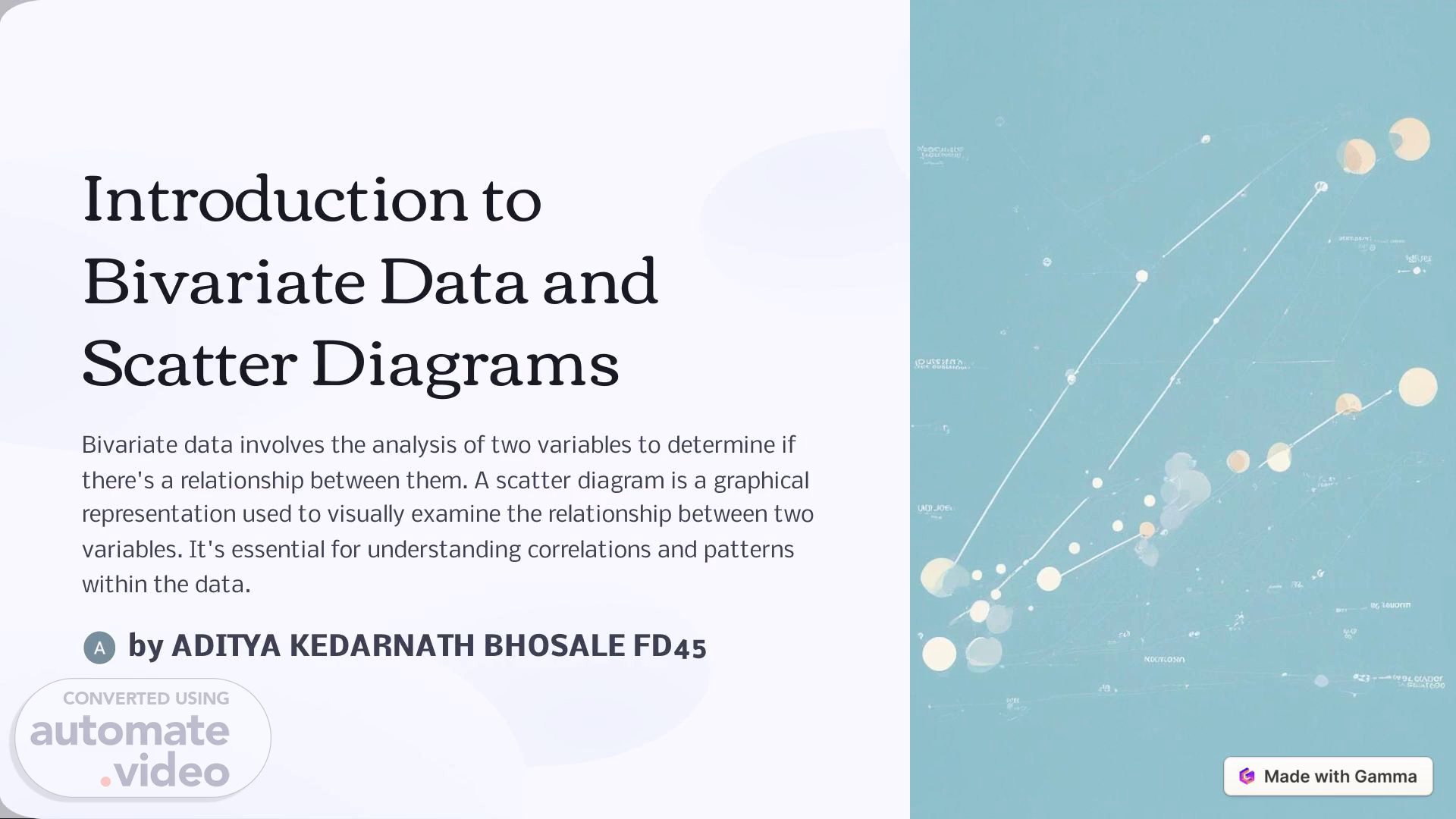
Introduction to Bivariate Data and Scatter Diagrams
Scene 1 (0s)
[Audio] Introduction to Bivariate Data and Scatter Diagrams Bivariate data involves the analysis of two variables to determine if there's a relationship between them. A scatter diagram is a graphical representation used to visually examine the relationship between two variables. It's essential for understanding correlations and patterns within the data. by ADITYA KEDARNATH BHOSALE FD45.
Scene 2 (27s)
[Audio] Understanding Correlation and Its Importance The Importance of Correlation Correlation measures the strength and direction of the relationship between two variables. Understanding correlation is crucial for making predictions, detecting outliers, and identifying the impact of one variable on another. Correlation Coefficients The correlation coefficient quantifies the strength and direction of the linear relationship between two variables. It provides a clear numerical value to interpret the degree of correlation present in the data..
Scene 3 (1m 2s)
[Audio] Positive Correlation and Its Characteristics Definition of Positive Correlation Positive correlation indicates that as one variable increases, the other variable also increases. It suggests a direct relationship between the two variables, where they move in the same direction. Strength of Positive Correlation The strength of positive correlation is determined by how closely the data points cluster around the line of best fit. The closer the points, the stronger the positive correlation. Examples of Positive Correlation Examples of positive correlation include the relationship between education level and income, as well as the correlation between exercise frequency and overall health..
Scene 4 (1m 46s)
[Audio] Negative Correlation and Its Characteristics 1 Negative Correlation Defined Negative correlation indicates that as one variable increases, the other variable decreases. It suggests an inverse relationship between the two variables, where they move in opposite directions. 2 Strength of Negative Correlation The strength of negative correlation is determined by the steepness of the slope of the line of best fit. The steeper the slope, the stronger the negative correlation. 3 Examples of Negative Correlation Examples of negative correlation include the relationship between outdoor temperature and heating costs, as well as the correlation between stress levels and sleep quality..
Scene 5 (2m 33s)
[Audio] Zero Correlation and Its Characteristics Zero Correlation Explained Zero correlation implies that there's no linear relationship between the two variables. Changes in one variable do not predict changes in the other; they are independent of each other. Characteristics of Zero Correlation Data points are scattered randomly across the scatter diagram, indicating no discernible pattern or trend. The line of best fit is horizontal, showing no slope..
Scene 6 (3m 5s)
[Audio] Non-linear Correlation and Its Characteristics 1 Non-linear Correlation Overview Non-linear correlation indicates a relationship between variables that is not perfectly linear. It may exhibit a curve, spiral, or other non-linear pattern in the scatter diagram. 2 Characteristics of Non-linear Correlation The scatter diagram may show a parabolic shape, a sinusoidal curve, or other non-linear patterns, indicating a complex and curvilinear relationship between the variables..
Scene 7 (3m 39s)
[Audio] Examples of Each Type of Correlation Using Scatter Diagrams 1 Positive Correlation Example An example of positive correlation could be the relationship between hours of study and exam scores, with data points clustering upwards along a positively sloped line of best fit. 2 Negative Correlation Example For negative correlation, consider the relationship between car speed and distance to brake, where data points cluster downwards along a negatively sloped line of best fit. 3 Zero Correlation Example An example of zero correlation may involve the relationship between shoe size and favorite ice cream flavor, with data points scattered randomly without any pattern or trend. 4 Non-linear Correlation Example Non-linear correlation can be observed in the relationship between temperature and cricket chirping frequency, where the scatter diagram exhibits a curvilinear pattern..
Scene 8 (4m 39s)
[Audio] Conclusion and Key Takeaways Understanding the types of correlation using scatter diagrams is crucial in analyzing and interpreting relationships between variables. Whether it's positive, negative, zero, or even non-linear correlation, each type provides valuable insights into the nature of the connections present in the data. By examining scatter diagrams and recognizing the characteristics of each correlation type, researchers and analysts can make informed decisions and predictions based on the observed patterns..